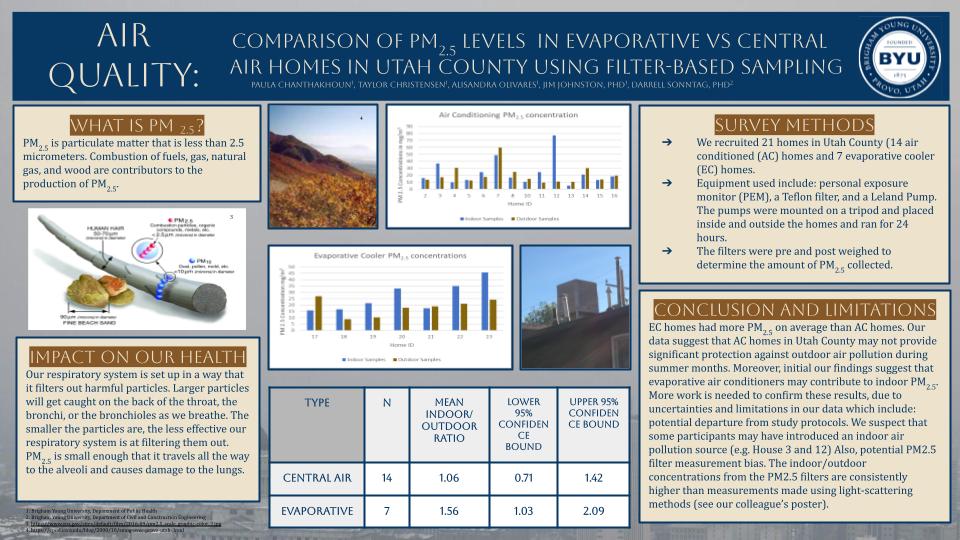Presenter Name: Paula Chanthakhoun
Additional Presenters:
Taylor Christensen (taylorrichchristensen@gmail.com); Alisandra Olivares (alisandraolivares@gmail.com)
Description
Exposure to particulate matter with an aerodynamic diameter of 2.5 μm or less (PM2.5) -is associated with varied adverse health effects such as chronic obstructive pulmonary disease (COPD), heart disease, and lung cancer.1 Housing can provide protection from outdoor air pollution, but the level of protection may vary depending on the type of air conditioning system used. In this study, indoor and outdoor air quality were compared between homes utilizing central air conditioning(AC; n=14) and evaporative cooling (EC; n=7). We pre-weighed 37-mm polytetrafluoroethylene (PTFE) filters (pore size 2.0 μm) then placed them in PM2.5 Personal Environmental Monitors (PEM). To prepare the PEMs, impact plates were greased and each part wiped down with a KIM wipe. Following this, the Leland Legacy Pumps were connected to their assigned PEMs and calibrated to 10 ± 0.1 liters per minute. Indoor and outdoor PM2.5 samples were collected at each study home. Participants were asked to refrain from cooking, burning candles or incense, or vacuuming indoor for 24 hours during the sampling period. PTFE filters were then post-weighed and the Leland pumps were post-calibrated. The PM2.5 concentration was then calculated. EC homes had more PM2.5 on average than AC homes. The indoor to outdoor air pollution ratio (I/O) of AC homes was 0.95, while the I/O of evaporative cooler homes was 1.50. Our data suggest that AC homes in Utah County may not provide significant protection against outdoor air pollution during summer months. Moreover, our findings suggest that evaporative air conditioners may contribute to indoor PM2.5, although the mechanisms behind this are unknown. One explanation is that the large volume of air introduced into EC homes may stir up settled dust in the house. This, in combination with outdoor PM2.5 brought into the home through the evaporative cooler, may explain the I/O ratio greater than 1.0. We are limited by a small sample size. Our next steps include comparing the outdoor PM2.5 concentrations measured in our study to nearby reference monitors operated by the Utah Division of Air Quality, and adding more homes to the study in summer 2023.
University / Institution: Brigham Young University
Type: Poster
Format: In Person
Presentation #C76
SESSION C (1:45-3:15PM)
Area of Research: Science & Technology
Email: paulachanthakhoun@gmail.com
Faculty Mentor: Jim Johnston

